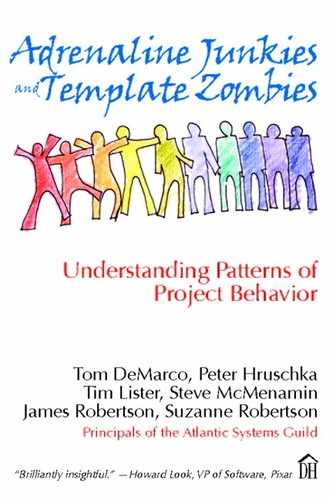44. The Blue Zone
,
“Orville Wright didn’t have a pilot’s license.”
—Richard Tait, Grand Poo Bah, Cranium
The team has at least one member who routinely exceeds authorization.
Meet Winston. Winston typifies a certain personality that you encounter from time to time on development projects. He’s not quite an anarchist, but he seems to report only to himself. He appears to do pretty much what he sees as best for the project, regardless of his marching orders. And yet, he never really goes too far. He just stretches his authority—and sometimes his manager’s patience—near to the breaking point. Winston operates in the blue zone.
When a manager hands out assignments, he sets boundaries such that the recipient has enough latitude to achieve the objectives of the assignment, while taking into account the team member’s abilities. The manager also tries to prevent different assignments from overlapping or colliding.
Thoughtful task definition establishes a wide lane within which the assigned team member may operate freely. However, it is almost impossible to specify exactly everything that needs to be done as part of the assignment. We think of project assignments as creating three zones of authorization:
• The green zone consists of the things that are explicitly a part of the assignment: the core of the work to be done.
• The red zone includes anything that is explicitly excluded from the scope of the assignment.
• The blue zone is everything else: activities that are neither required nor prohibited by the assignment. In other words, everything that lies between the green and red zones.
Our colleague Winston believes that he can do anything that he has not been explicitly told not to do. Not only will he carry out the assignment as stated (his green zone), but he also feels he should do anything in the blue zone he thinks needs to be done to achieve the best outcome. His only criterion for acting is that whatever he does must be beneficial to his project. He doesn’t wait for permission; he doesn’t ask for it. He just does whatever he thinks needs to be done.
There is more to Winston. We sometimes see him attempting to persuade the team leader to let him operate in the red zone. Permission to do what he has been told explicitly not to do is the only permission he seeks.
Having a Winston on your team is a real benefit. Although life with him can be hair-raising, he gets things done. And his adventurous nature means he often comes up with better and more-innovative solutions than those envisioned by the original assignment.
Winston looks especially valuable when you consider Benson, his polar opposite. Benson is the fastidious team member who assumes that unless he has been specifically told to do something, he must ask for permission before doing anything. For Benson, the blue zone is out of bounds. Regardless of the value of doing so, he ventures there rarely and only after asking explicit permission.
Because he has been told not to venture into the red zone, Benson sees this prohibition as both everlasting and beyond questioning. He might even stand by and watch the project fail rather than suggest a solution that lies in the red zone, far beyond the scope of his formal assignment.
Both Benson and Winston personify paradoxes: One shows that strict obedience can be harmful; the other demonstrates the potential value of some benevolent anarchy.
“The correct amount of anarchy on a project is not zero.”
—Mike Mushet
